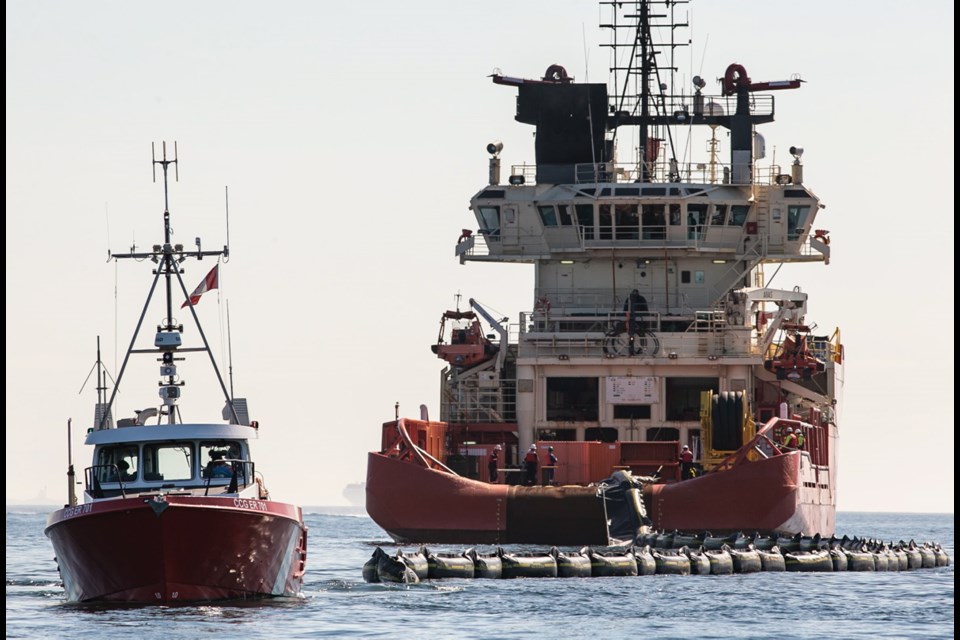The Canadian and American coast guards conducted a joint, two-day oil-spill drill last week to test the emergency response to an accident in the waters between sa���ʴ�ý and Washington state.
The two coast guards, along with third-party response teams from both countries, conducted one drill off the coast of Port Angeles on Wednesday. Thursday’s drill took place about a half-hour boat ride from Victoria’s harbour.
The exercises were the largest drills on water the two countries have performed together, said Jeff Brady, deputy superintendent for coast guard environmental response in Western sa���ʴ�ý.
The environmental impact of a large oil spill would be “staggering,” said Chris Genovali, executive director of Sidney-based conservation group Raincoast. The 1989 Exxon Valdez oil spill in Alaska killed more than 1,000 sea otters and about 250,000 seabirds immediately due to hypothermia, drowning and poisoning by the oil, Genovali said. Toxic fumes from the oil were thought to have killed harbour seals and killer whales. The impact on their populations took years to measure.
Pipelines and oil spills are a growing concern to many on the West Coast, as the federal government tries to move forward with an expansion to the Trans Mountain pipeline, which would see an increase in tanker traffic transporting oil.
Michael Lowry, of Western sa���ʴ�ý Marine Response Corp., said these international drills are crucial to ensuring both countries are prepared to respond effectively in the event of a spill. About 5,000 deep-sea vessels transit Juan de Fuca Strait.
The corporation is tasked with responding to oil spills along sa���ʴ�ý’s 27,000 kilometres of coastline. Regulated by Transport sa���ʴ�ý, the corporation is funded by companies involved in the oil industry, such as oil-handling facilities and large vessels that call at Canadian ports. About 15 per cent of oil is recovered on average following a spill, Lowry said.
“A lot of that is non-recoverable, so it’s either evaporated or it’s dissipated into the water. It’s not necessarily that that other part hasn’t been cleaned up. It’s just been absorbed by the environment,” he said.
Last week’s drills involved 169 people and 19 vessels and aircraft to simulate an oil spill and test the joint response. Aircraft were deployed to track the spread of a green, non-toxic substance to simulate oil.
The primary goals of the drills were to familiarize each country with the other’s response equipment, ensure everyone can communicate to co-ordinate a response and test border crossings with equipment and personnel.
“We work with our vessels a lot,” Lowry said, but they don’t work with American vessels very often. “Will the valves connect? Will the pumps work? That’s the kind of stuff they’re testing.”
An agreement between sa���ʴ�ý and the U.S. requires a drill every two years, but an exercise on water does not happen often, Lowry said.
Oil spills can occur at oil-handling facilities, from vessels transporting oil and as a result of pipeline ruptures, he said.
The largest spill the corporation has responded to was a pipeline rupture in Burnaby in 2007, and it has never seen a tanker spill, Lowry said.
The process to clean up oil spills in sa���ʴ�ý uses inflatable tubes, called booms, deployed from boats to contain the oil on the water’s surface. A skimmer made up of brushes then picks up the oil, and it’s pumped into a barge. The oil is transported to a treatment facility to be recycled for asphalt or incinerated if it contains too much water.
Cleanup crews turn their attention to the shores only after the water has been cleaned.
Transport sa���ʴ�ý requires the corporation to have enough equipment to be able to clean up 10,000 tonnes of oil in 10 days and 500 metres of beach per day.



